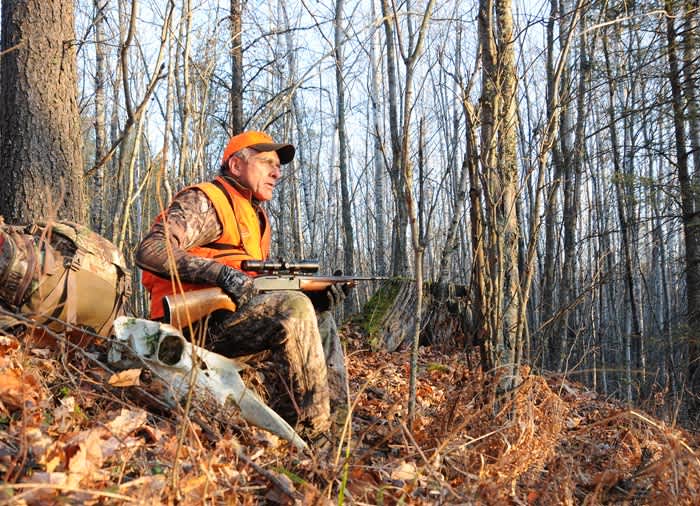Minnesota and Its Missing Moose
Patrick Durkin 03.12.13

When finding mountains of moose droppings and sometimes seeing more moose than whitetails during my past 10 deer seasons in northeastern Minnesota, I assumed the region would forever hold strong moose numbers.
After all, the moose’s horse-size tracks were common in fresh snow, as were chin-high rubs on bark-shredded balsams. I also regularly packed out moose skulls and antlers I found while hunting deer.
Plus, I saw moose regularly. One day this past November, for example, I heard snapping branches and muck-sucking hoofs ahead while sneaking along a black-spruce bog. Instinctively, I half-shouldered my .280 rifle and scanned above and beyond its scope. I relaxed when spotting a cow moose high-stepping through spruce and tag alders, its calf close behind.
What a sight. These homely creatures are tall, dark, and gangly; the closest thing you’ll ever see to Abe Lincoln on four legs. Still, their appearance didn’t shock me. I’d seen more moose sign than deer sign the previous three hours.
But looks can deceive when applied beyond the roughly 10 square miles my friends and I hunt in and around Minnesota’s Boundary Waters Canoe Area Wilderness. Outside our moose hot spot, northeastern Minnesota’s moose numbers have plunged so far that the state’s Department of Natural Resources (DNR) announced in February it was canceling this fall’s moose hunt.
Just so we’re clear, hunting didn’t hurt the moose herd, and closing the season won’t spark its rebound. Hunts since 2007 were limited to bulls, and the state sold only enough tags to reduce the herd by 2 percent.
Although their DNR won’t say it, Minnesotans might never again hunt moose in their state. The last time Minnesota closed the hunt with no timetable for return was 1923, when moose numbered 3,000 statewide, and were beset by poor habitat from rampant logging and wildfires.
As forests regrew the next 50 years, moose returned. Hunting resumed in 1971 in odd-numbered years when moose numbers averaged 5,000 to 8,000 in northwestern and northeastern Minnesota.
The northeastern hunt closed in 1991 but reopened in 1993 as an annual season. The northwestern hunt continued until 1997 when its moose herd crashed. That region’s herd now seems doomed, despite improving habitat.

Meanwhile, the northeastern herd peaked at 8,840 in 2006, but generally suffered gradual, fluctuating declines since 2002. The drop recently worsened. The population estimate this winter was 2,760, a 69 percent plunge from seven years ago. That’s also a decline of 52 percent since 2010 and 35 percent from a year ago.
Unlike the crisis of habitat 90 years ago, this calamity isn’t so easily diagnosed. To learn more, researchers between 2002 and 2008 attached radio-transmitting collars to 150 moose. The results improved the DNR’s aerial surveys, and helped the biologists track moose movements and home-range sizes, as well as survival rates.
Unfortunately, the research couldn’t explain what kills most moose. Of the study’s 89 non-hunting moose deaths from 2002 to 2010, 74 percent remain of unknown cause. Known causes are vehicle collisions, 11 percent; wolves, 10 percent; poaching, 3 percent; and train collisions, 2 percent.
What’s the best guess for the decline? Biologists speculate it’s a deadly combination of chronic health woes and physical stress linked to warmer, shorter winters and hotter, longer summers.
Moose are built for winters and habitats whitetails can’t long tolerate, making the upper Great Lakes’ forests the southern fringe of moose country. Researches believe a moose’s summer coat causes stress in temperatures above 64 degrees, and its winter coat causes stress in temps above 19 degrees. Temperatures in recent summers hit the 80s or 90s for weeks. Likewise, recent winters were among the mildest on record.
All that warmth also unleashed tick infestations. Some dead moose literally crawl with ticks. Estimates of tick numbers on some host moose range from 50,000 to 150,000.
Further, biologists have long hypothesized that moose herds can’t tolerate large deer herds because moose often die from brain worms that deer carry but shed without being harmed. As northern Minnesota’s deer herds increased since the 1980s, it’s possible brain worm problems worsened for moose.
The Minnesota DNR hopes a $1.2 million study launched this winter will help explain the population crash. Researchers recently attached GPS collars to 111 moose to better document their patterns and movements.
The collars also signal if the moose dies. With GPS pinpointing death sites, researchers hope to respond quickly to determine the cause of death before heat or freezing cold destroys vital clues, such as the tracks brain worms cut through tissue.
Explaining a population crash, however, doesn’t mean rebuilding it. Nature, after all, remains beyond our control.

